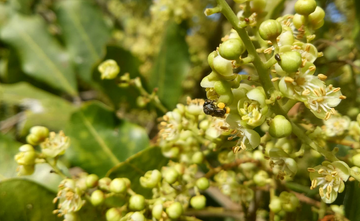
What keeping Bush Bees involves
Australian native stingless bees are very low maintenance. However, there are a few things that you can do to make it as easy as possible for your bees to thrive.
-
Position your hive well
-
If it gets above 35c, cover your hive with a moist towel - the evaporation will keep your hive cool
-
Keep a flight path in front of the hive clear of obstacles such as spider webs
-
Bush Bees can fly around 500m away, so do not worry about not having enough flowers in your garden. However, if you would like to see your bees foraging on your garden, I would definitely recommend planting some bee-attracting plants (see here)
-
Bush Bees will not fly outside until it is above 18c - this means that you may not see much activity during winter, so do not get alarmed
-
You do not need to split your hive or harvest honey. However, we recommend that you split your hive at least once to ensure that if one hive dies, you have a backup.
-
DO NOT use any garden sprays within 30m of the hive.
-
Unlike honey bees, native bees do not need a nearby water source. They collect all that they need from flowers.
-
Again, unlike honey bees, native bees do not require a permit to be kept.
Where to get a Bush Bee Hive
Ready to make the leap of faith (you won't regret it) and get bitten by the bee bug? Here are a few ways to get a native bee hive.
-
The easiest way to get a native stingless beehive is to buy one
-
You can buy an empty hive, and then use it to split a friends hive
-
You can rescue a hive of Bush Bees from a dangerous hive location
How to position a hive of Australian Native Bees
Now that you have your native beehive, you need to find a suitable location for it. Here are a few tips. Please note this information is intended for Sydney locations with a Bush Bees hive. Feel free to contact us if you have any questions.
-
The position should receive morning sun (until ~9:00am) in Winter, and have full shade in Summer
-
Preferably raise them 10cm or more off the ground (not necessary)
-
Ensure that they are protected from rain
-
They must have a clear flight path (no spider webs, etc) outside
-
Watching the bees coming and going from their hive is very enjoyable, so it is recommended that you place your beehive in an easily accessible and viewable location, such as a balcony
-
Do not place your hive directly above a pool as the bees may mistake the blue water for the sky and dive into the water.
Once you have suitably placed your bees, you can release them by sliding the clear gauze caps off the black elbows. The bees will begin to forage.
Maintenance
Generally, you should not have to do much to look after your hive. Periodically check on the bees on a warm day to make sure there is activity at the entrance. You do not ever need to duplicate your hive or harvest honey. If you have any questions, contact your supplier.
Moving Hives
It is easy to move your hive under 50cm, or over 1km. It can get more complicated if you want to move it distances between those two.
-
Moving hives under 50cm - If you need to move your hive a distance of 50cm or less, simply move the hive. The bees with adjust within a day.
-
Moving hives over 1km - If you need to move your hive a distance of 1km or more, again, simply move the hive. The bees will adjust quickly to their new location.
-
Moving hives distances between 50cm and 1km - This can get a bit more complicated. There are 2 methods of doing this:
- Method 1: Move the hive 50cm a day, until they reach their desired location.
-
Method 2: Move the hive over 1km away for 3 or more weeks. Then, move the hive back to it's desired location.
Related Articles




